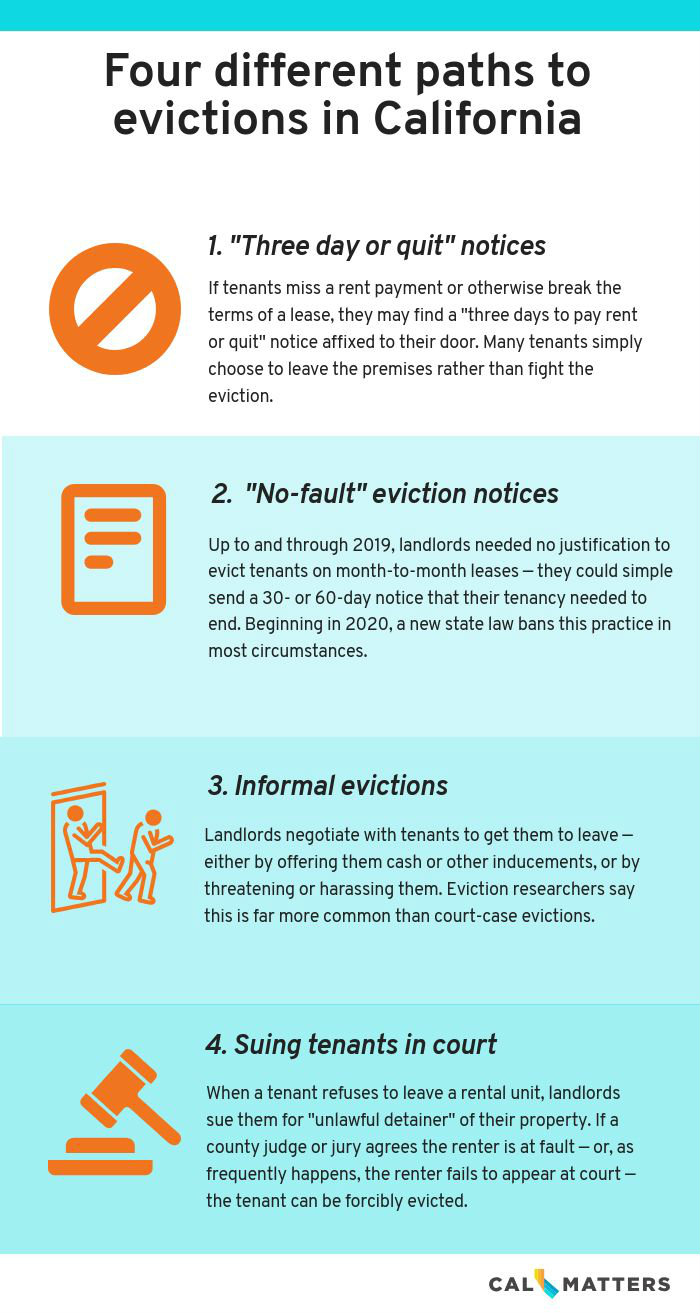Theoretically that should have swelled the ranks of tenants needing her to defend them in eviction court. Ever-escalating rents should make it harder to pay rent on time, and delinquent payments are the most common reason a landlord sues to remove tenants from their property. Cutthroat demand presumably would spur landlords to evict more readily, knowing they won’t risk months of lost revenue in a post-eviction vacancy.
Yet eviction lawsuits against San Mateo renters from 2010 to 2018 dropped nearly 50%.
“This year is going to be the lowest you’ve ever seen,” said Gibson. “I don’t have a perfect explanation for why that is the case.”
It’s counterintuitive amid a worsening housing crunch, but it’s happening statewide. While the median rent in California increased 23% between 2011 and 2018, the number of times California landlords sued their tenants to evict them dropped by nearly 40% over roughly the same period, according to data collected by UCLA researchers.
Two crucial caveats: Those dropping numbers nonetheless represent a significant number of California renters facing the prospect of a court-ordered eviction — landlords initiated more than 137,000 of them in fiscal year 2017. And there’s no data on evictions that don’t end up in court, although researchers estimate they’re about twice as common as those that do.
Still, the data shows a steep and steady drop in eviction court cases this decade in every sizeable county — with cases diminishing more in some of the priciest areas.
“It’s a puzzle that I’m not sure we have an answer to,” said UCLA eviction researcher Kyle Nelson.
Are landlords simply expanding efforts to evict tenants outside the courts? Have attempts to beef up legal aid to low-income residents paid off?
Neither academics nor landlords nor tenants can say definitively. But here are some of their best guesses.
Evictions outside court could be rising (but we lack data to know for sure)
An unfavorable court judgement hangs an enduring legal albatross on renters — what some have termed “the Scarlet E.” In California, evictions stay on a tenant’s rental history for seven years, during which it becomes incredibly difficult to find another place to live.
But eviction lawsuits are one of the few forms of eviction that actually leaves a data trail. And that only happens if a renter stays in an apartment after being served with an eviction notice, forcing a landlord to go to court.
Landlords have plenty of other options. California doesn’t know how many families move out after a “three days to pay rent or quit” sign is affixed to their door, let alone how many strike “cash for keys” arrangements or other informal agreements to leave. (If a renter moves out because the rent is raised, that’s not an eviction).

Eviction researchers say even absent data, there’s good reason to think these undocumented evictions could be on the upswing. High rents and low vacancies mean landlords may be more willing to waive delinquent rents, buy out tenants or otherwise induce or threaten them, to get them to leave.
“Say there’s more rent increases and more tenant harassment, and either way a tenant has to move,” said Aimee Inglis, program director with Tenants Together, a statewide renter advocacy group.
Gibson, the San Mateo tenant attorney, says she’s seen a dramatic uptick in “no-fault” evictions over the past decade, even as court cases have declined. Until a new California eviction protection was passed in 2019, landlords could force renters to leave after their leases expire without giving a specific reason why, as long as they’re given 30 or 60 days notice.
Why have landlords used “no-fault” evictions?
Say a landlord suspects a tenant is dealing drugs on their property, but lacks proof. If the tenant fights that in eviction court, the landlord could very well lose. But if the landlord simply sends a “no-fault” notice that a tenancy will end in two months, the renter is typically out of options.
Renter advocates say landlords often abuse “no fault” evictions to retaliate against tenants who ask for expensive repairs or maintenance. The practice can also camouflage illegal discrimination.
“Instead of these fault-based cases, we’re getting these much harder to defend no-fault types of cases where legally they are harder to wrangle,” said Gibson.
In 2013, roughly half of the eviction notices clients brought to her legal aid clinic were “no-fault” lease terminations. By 2018, that share had increased to 75% — a more common reason than non-payment of rent.
There’s no statewide data on the number of “no-fault” notices. Reports of their prevalence have surged in recent months because a new state law is about to restrict them. After Jan. 1, most landlords will be required to cite one of several acceptable reasons for evicting a tenant.
It’s partly the economy — but that’s not the whole story.
As the Great Recession of the late 2000s ravaged California’s economy and housing market, eviction lawsuits spiked. Adding to the misery of unemployment reaching levels not seen since the Great Depression, banks and corporate landlords frequently served eviction notices to families who lost their homes in foreclosures. The result: nearly 230,000 eviction court cases in fiscal year 2010.
Landlords say eviction lawsuits also increased during that time because the same population most vulnerable to foreclosures — families with shoddy credit histories and incomes too small for their mortgages — were likely to miss rent payments after they moved from foreclosed homes into rentals.


